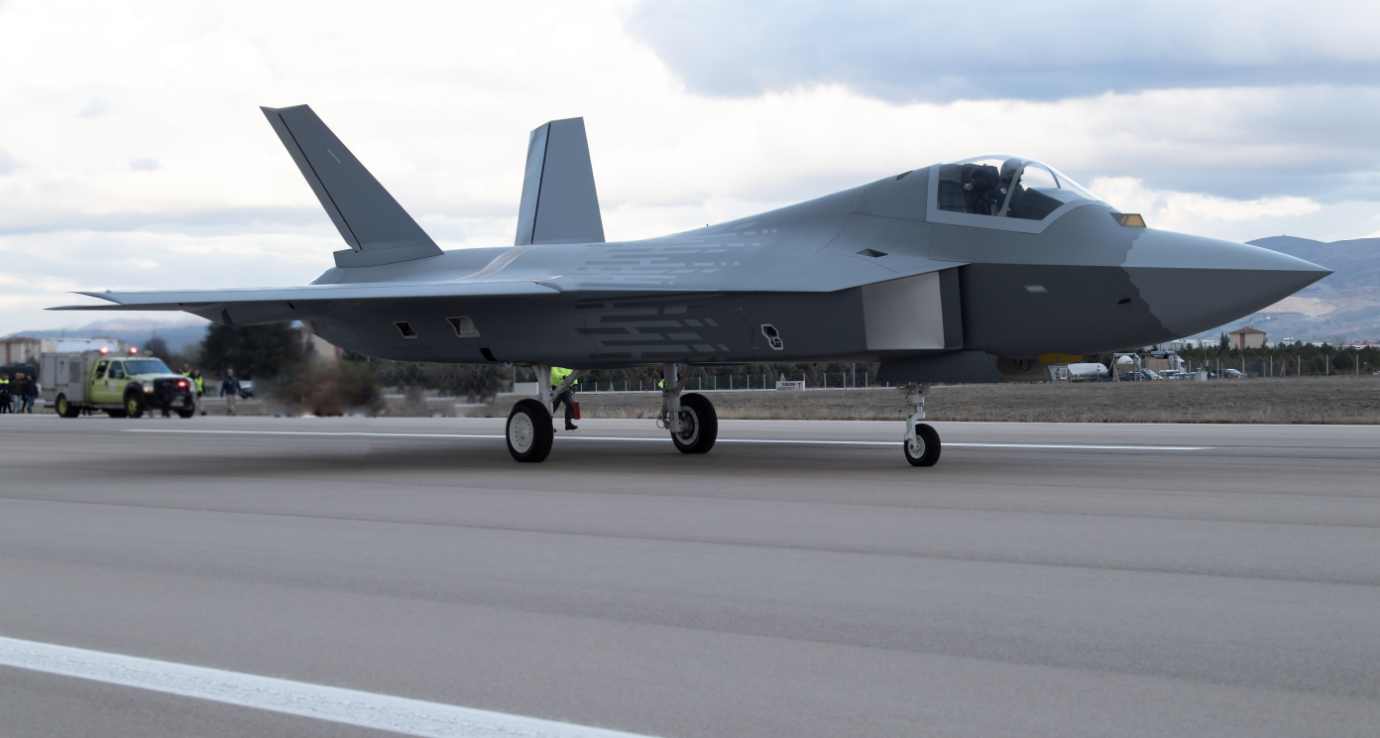The 16th International Defense Industry Fair (IDEF 2025), held at Istanbul’s TÜYAP Fair Convention and Congress Center, concluded this week with the attendance of over 1,500 exhibitors from over 60 countries and thousands of defense professionals. Organized under the auspices of the Turkish Ministry of National Defense, the event reinforced Turkey’s growing role as a global defense exporter and innovation hub.
IDEF 2025 saw the unveiling of several high-profile defense platforms, important arms sales agreements, and next-generation technologies that reflect the growing ambition and capability of Turkey’s domestic defense industry.
Key Product Launches and Debuts

- (TAI)
1. KAAN Fifth Generation Fighter Jet – Production Variant
Turkish Aerospace Industries (TAI) revealed the full production variant of its KAAN Fifth Generation Fighter Jet. Building on the momentum gained from a recent $10 billion export deal with Indonesia, TAI showcased upgrades including refined stealth contours, upgraded mission computers and an enhanced cockpit interface.

- (Emir GEÇİR/Wikimedia)
2. Altay MBT – Serial Production Configuration
BMC displayed the latest serial production model of the Altay main battle tank, which includes South Korean transmission systems and Aselsan’s locally produced active protection suite (AKKOR). The Turkish Armed Forces are expected to receive the aircraft by 2025. The first batch is expected to be received in late 2025.
3. Bayraktar TB3 and KIZILELMA Drones
Baker displayed the navalized TB3 UCAV configured for short-deck operations, as well as the latest iteration of the jet-powered KIZILELMA unmanned fighter, which includes improved avionics, air-to-air weapons integration, and stealth coatings.
4. Marlin USV – Armed Unmanned Surface Vehicle
The Turkish Navy and ASELSAN co-presented the Marlin USV, which is now operational with remote weapon stations and sonar systems for coastal surveillance, mine countermeasures, and anti-submarine warfare.

5. Rocketson Hypersonic Glide Vehicle (HGV) Concept
In a significant leap, Rocketsan unveiled its concept design for a hypersonic glide vehicle system, part of Turkey’s long-term strategic strike ambitions. Officials noted that it is under a feasibility review for testing by 2027.
Read Also: U.S. Military Eliminates Senior ISIS Leader and Two Sons in Precision Raid in Syria
Arms Sales and Strategic Agreements
More than $13 billion in defense export deals were signed on the occasion. Highlights from the IDEF 2025 show, including:
- Indonesia – $10 billion deal finalized for 48 KAAN fighters (Turkey’s first fifth-generation aircraft export).
- Qatar – MOU signed with Havelson for battlefield management software and integrated command systems.
- Azerbaijan – Bayraktar TB3 drones and additional Rocketsan agrees to buy smart ammunition.
- Pakistan – Expands its collaboration with STM on naval corvette modernization and drone technology.
Defense Industry President Haluk Gorgun called the deals “proof of global confidence in Turkish systems,” noting that Turkey’s defense exports are on track to exceed $8 billion in 2025, breaking previous records.
Emerging Technologies and R&D Highlights
IDEF 2025 also served as a showcase for Turkey’s rapidly growing defense R&D sector, particularly AI, electronic warfare, and space-based systems:
- AI-Enabled C4ISR Systems – ASELSAN introduced new artificial intelligence modules for autonomous threat identification, automated targeting, and strategic battlefield analysis, integrated into command-and-control systems across multiple domains.
- TURKSAT 7A Military Payload Demonstration – Türksat and TÜBİTAK introduced a new secure satellite communications terminal and showcased the upcoming launch of TURKSAT 7A, which will carry a military-grade communications payload to expand Turkey’s strategic data relay capabilities.
- Directed-Energy Weapons – TÜBİTAK SAGE and Aselsan demonstrated advances in compact laser defense systems for drone and mortar threat neutralization, planning field testing in early 2026.
Turkey’s Rise as a Global Defense Power
IDEF 2025 served not only as a showcase for Turkey’s latest military innovations but also as a clear reflection of the country’s growing stature as a first-tier defense manufacturer and strategic actor on the global stage.
From Import Dependence to Strategic Autonomy
Historically dependent on NATO allies for high-end systems, Turkey’s drive towards defense self-sufficiency gained momentum in the early 2010s, driven by political tensions, arms embargoes, and operational limitations in foreign-supplied equipment. In response, Ankara prioritized domestic defense production under the “National Technology Initiative” (Milli Teknologi Hamleci), with strong support from the Presidency of Defense Industries (SSB).
The result has been a dramatic surge in indigenous capabilities across the defense spectrum: from drones and guided munitions to warships, satellites, and fighter aircraft. Today, more than 80% of the equipment used by the Turkish Armed Forces is produced domestically – a stark contrast to a decade ago, when foreign systems dominated purchases.
A Top-tier Defense Manufacturer
Turkey is now one of the few countries globally capable of designing, developing and manufacturing complex, multi-domain weapons systems. These include:
- Fifth-generation aircraft (KAAN)
- Armed drones and unmanned fighter jets (Bayraktar TB2, Akinci, Kızılıçlık)
- Advanced armored vehicles and main battle tanks (Alte)
- Precision-guided munitions and ballistic missiles (SOM-J, Bora, Taifun)
- Indigenous naval platforms (Istif-class frigates, Milgem corvettes, Reis-class submarines)
- Electronic warfare and AI-integrated battlefield systems (ASELSAN, HAVELSAN platforms)
- TCG Istanbul (F-515) crosses the Bosphorus in October 2023. Developed under Turkey’s MILGEM program, the Istif-class expands on the Ada-class design with the MIDLAS vertical launch system for greater range and multiple roles. (Adem/Wikimedia)
This ecosystem is supported by a growing network of state-owned and private sector companies, including Turkish Aerospace Industries (TAI), Roketsan, Baykar, BMC, FNSS and STM – many of which now collaborate directly with foreign partners as suppliers and joint developers.
Defense Exports Increase
Turkey’s defense exports are projected to reach $8 billion in 2025, from less than $1 billion in 2010. Signature sales include:
- Bayraktar drones to over 30 countries, including NATO members, African states, and Central Asian partners
- Naval ships to Pakistan, Qatar, and Ukraine
- Air defense systems, armored vehicles, and guided munitions to Asia, Africa, and the Middle East
- Historic $10 billion KAAN fighter deal with Indonesia, placing Turkey among an elite group of fighter jet exporters
- The Bayraktar TB2 is a Turkish-made medium-altitude long-endurance (MALE) UCAV used by the Turkish Armed Forces. It supports remote or autonomous operations and is controlled from a ground station, including weapons deployment. (Bayhaluk/Wikimedia)
What distinguishes Turkey’s export strategy is its ability to offer high-performance, combat-proven platforms at competitive prices with limited political implications—an attractive proposition for countries seeking alternatives to U.S., Russian, or Chinese systems.
Expanding Global Influence
In addition to arms sales, Turkey’s defense diplomacy is expanding its strategic footprint. Turkish military advisors, training programs, and logistics partnerships now appear in Africa, Central Asia, and Southeast Asia. Turkey has also become a key interlocutor in regional conflicts from Libya to the South Caucasus—where it uses its military-industrial capabilities for geopolitical gain.
Participation in multinational defense initiatives, such as joint production with Pakistan and strategic dialogues with Gulf states, reflect Ankara’s efforts to shape the regional security order on its own terms.
At the same time, Turkey’s balanced position – cooperation with both NATO and non-Western partners – has enhanced its role as a versatile actor navigating between Western security structures and emerging multipolar dynamics.
Conclusion: From emerging to established
IDEF 2025 underscored what has now become clear to defense observers around the world: Turkey is no longer an emerging defense player – it is an established, top-tier defense industrial power with a growing global reach. Whether through combat drones shaping the outcomes of war, through its penetration of global markets through fifth-generation fighters, or through its expanding diplomatic-military influence, Turkey is poised to become a central force in the evolving global security landscape.
As Ankara continues to innovate, export, and engage, the coming decade will see Turkish defense platforms not only exported but also co-produced, standardized, and fielded with traditional industry leaders.
Read More: Space Force to Launch Eighth X‑37B Spaceplane Flight Next Month
FAQs: Frequently Asked Questions
The main attraction was the unveiling of the production model of Turkey’s KAAN fifth-generation fighter jet. Following the $10 billion export deal with Indonesia, it garnered global attention, as it marked the first time Turkey exported such an advanced fighter jet. This deal is a topic of discussion worldwide, as it positions Turkey alongside major jet-exporting nations like the US and Russia.
Turkey showcased new versions of its Bayraktar TB3 and Kizilirmak drones, designed for naval and stealth missions. These drones have already proven their capabilities in combat, and over 30 countries use them, making them a constant topic of discussion. Along with the drones, ASELSAN’s AI-enabled battlefield systems are also attracting global interest, utilizing machine learning for threat detection and automated targeting. AI in the defense sector is a rapidly growing trend on Google.
The most discussed future project is Roketsan’s hypersonic glide vehicle (HGV), expected to be tested by 2027. Hypersonic weapons are a topic of discussion worldwide because they travel at speeds exceeding Mach 5 and can evade most missile defense systems. Turkey’s entry into this field remains a topic of online discussion, as it reflects the country’s ambition to compete with the US, China, and Russia in next-generation strategic weapons.
Check Also: Space Force to Launch Eighth X‑37B Spaceplane Flight Next Month








Leave a Reply